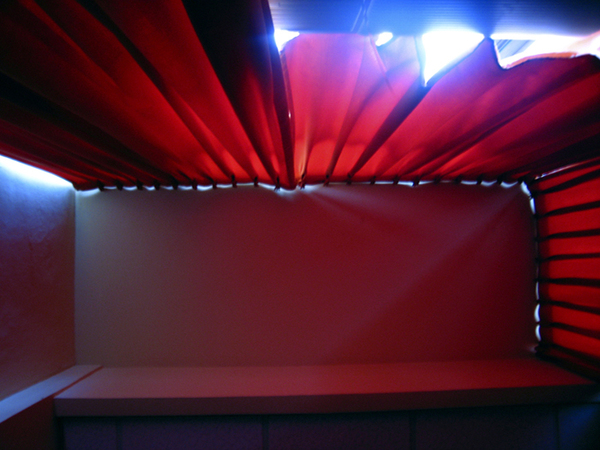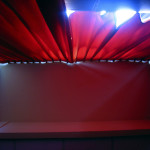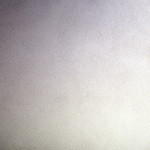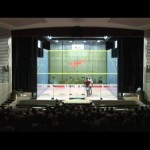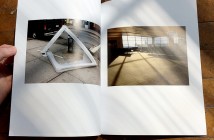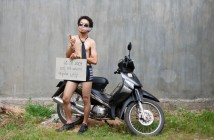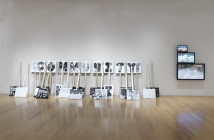Carlin Wing has a habit of pointing a camera up at the ceiling. Up there, on the blank ceiling, is nothing. Maybe some weird old marks, a light, a crack if the building is old enough, or some kind of architectural pattern. What is it about ceilings that are compelling Wing to turn her camera up?
Ceilings Where I Sleep is a collection of photographs and index cards mounted just shy of five feet off the floor in a left to right, all in a linear progression. Each photo has a corresponding card catalog entry describing the moment captured including such details as drinks from that evening, the location of the ceiling, and other hints as to why Wing was sleeping there. Curious visitors can flip through the cards, exhibited in the center of the room, to fill the images with more meaning, but I find that the photos cannot escape a level of ambiguity even with the information found on the corresponding card. For example, one of the most recent photos is of a cancer ward’s ceiling giving an emotional charge that is not readily present in the photo, yet neither the photo nor the card capture the complicated emotional roller coasters of cancer or hospitals. We are forced to project ourselves into that space and reflect on what we may have experienced in our own lives.
The photos cover the last five years of Wing's international wanderings. Each ceiling is captured at what seems like a random angle using throwaway cameras and cell phones to record the images. Among the locations portrayed are the house she grew up in, undergrad and grad school housing, the hotels and airplanes she encountered while traveling as a professional athlete, and recent rooms in which she has slept.
Even though these photographs are factual records of actual ceilings, when gathered together as a collection they evoke a silent visual poetry rather than a formal architectural exploration. Instead of being about ceilings, or an anthropological survey with random samples, this collection operates through the rhythm and metaphor of moments past, indirectly mentioning the details through the images and poetic descriptions on the cards. "Interview", "hangover", "Tom"– rather than describing the scene in prose, the images and the cards leave out significant details, implying but not stating what really happened.
A few of the photos are so low-fidelity that they are almost unintelligible. The camera, capturing the low light conditions, interjects digital artifacts into the image, showing that Wing does not place much emphasis on formal composition. It is an expansion of Wing's photographic oeuvre, which is partially built on formal images of art hung in law offices, and a thorough examination of her career as a professional squash player. Her well-known photograph of a squash game in Grand Central Station (2006) is a carefully configured arrangement exploding with details. The sparse images in the ceiling archive rely instead on the happenstance of a daily routine, on Wing consistently performing the physical act of capturing whichever features occur around her at bedtime. These evasive records are charged with empty conceptual space, like automatic drawings from sketchbooks, allowing for the viewer to project their own narratives into the spaces captured. In the gallery, the poetic glimpses captured in the photos fill the entire gallery, enveloping the viewers without attacking them. Instead, the images feel fun, enjoyable. They form an ebullient exploration of life and architecture that compliments her earlier formal work nicely.
In her video Hitting Walls, shown by Greaney a year ago, Wing considers that slippery, momentary loss of awareness found through the act of playing squash. This freedom from questions of selfhood and larger goals while immersed in play relies on unconscious, immediate engagement from the participants. Fast- forward to today, and Wing is again focused on a subliminal spontaneous action. Instead of engaging participants through games, she engages herself by requiring through habit that she snap an impression of the fleeting quiescent ambience at the end of her day. This simple structure enables the freedom we see in the photographs.
Maybe there is something to ceilings after all. Wing’s fragile disclosures of her life invite us to speculate freely about the plot of her somnolent global wandering. This collection of ceilings, without concrete anchor, allows us to engage with the photos in a way that feels transgressive. Instead of looking, and not touching, the card catalog allows us to interact with the work in order to find out where the photo comes from. We walk back and forth between photo and catalog to find out what we are looking at and to look at what we’ve been reading about. The occasional missing photo also serves to sustain the mystery of this well-traveled photographer by wondering what happened that she failed at her project that night.
We leave the gallery, filled with these hints and suggestions, and we find ourselves looking up.
- Carlin Wing, Pull out floor cushion, Room ?, INDES Sport Hotel, San Salvador, El Salvador, October 24-30, 2005, inkjet fiber print, 4×5 1/2″
- Carlin Wing, Home, 99 Marion St, Somerville, MA, September 1, 2005 – August 31, 2006, inkjet fiber print, 10×15″
- Still from Hitting Walls (v.iii), video, 2008
"Ceilings Where I Sleep" is on view through June at Anthony Greaney, located at 450 Harrison Ave., Boston, MA
All images are courtesy of the artist and Anthony Greaney.

